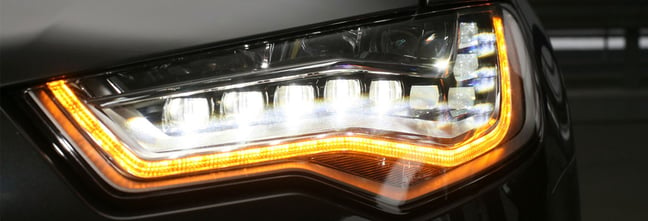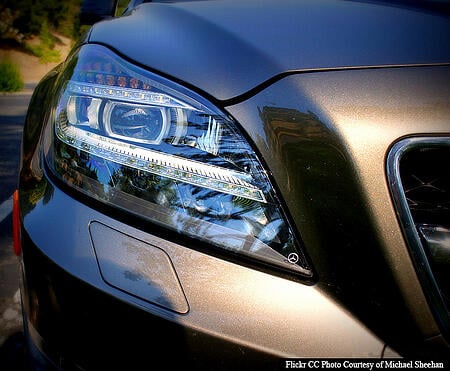

Jun 13 2014
Vehicle lighting technology has become increasingly more advanced to the point where, in some cases, it can make driving at night as safe and easy as driving during the day. With these new technologies on the market, drivers will no longer have to worry about blinding other drivers, guessing what's around the bend, whats walking (or crawling) out into the street, as well as mitigating bad visibility due to inclement weather conditions. Automakers have covered all aspects of vehicle lighting with new technology for high beams, headlights, fog lights and a number of complementary technologies.
Although vehicles have been equipped with high beams for quite some time, many drivers are bashful when it comes to utilizing them. Often times the only use they get is on very poorly lit back roads. The main reason for this would be that it's easy to forget when they're on, thus unintentionally blinding drivers of vehicles passing by or driving in front.
Some manufacturers in the automotive industry have created a way to take the driver out of the equation with intelligent high beams that can activate, deactivate, or adapt on their own.
The concept of the intelligent high beam automatic dimming technology is not brand new, however, it's much more effective with complementary metal oxide semiconductor (CMOS) camera technology. Prior to this technology - originally designed for space exploration - high beam dimming technology was operated by photo resistor systems. Unfortunately, they weren't able to discern streetlights from other vehicle lights and wouldn't dim when approaching cars from behind. The technology also had a tendency to get confused by the vehicle's light reflection off of street signs and dim the lights unnecessarily.
Starting in 2005, the Jeep Grand Cherokee was the first to use this high beam auto dimming technology. Through a microprocessor located on the back of the rear view mirror, CMOS controls the vehicle lighting, based on surrounding traffic activity. At night, if no other vehicles are detected nearby, the system will automatically activate the high beams at full capacity. If other vehicles are detected heading in either direction, the low beams will activate in place.
In 2008, Mercedes developed a more advanced intelligent high beam system called "Adaptive High Beam Assist." This system constantly (every 40 milliseconds) adjusts the high beams to the maximum brightness within reason of surrounding vehicles, rather than just switching between the low and high beam settings. The beams project from ranges between 200-900 feet and at close range, adjust vertically downward with shutters to prevent glare for other drivers. In 2011, Volkswagen developed an adaptive headlight technology that selectively dims certain areas of the headlights to prevent glare.
Unfortunately, these adaptive high beam systems are currently illegal in the U.S. due to an old law stating that when switching between low and high beams, there can't be any intermediate settings. Along with Mercedes and Volkswagen, several other manufacturers such as Toyota and Audi have also developed an advanced high beam technology and are battling with the NHTSA to make it legal in the U.S.
Intelligent headlights are an excellent complimenting feature to advanced high beam technology. Though great for increasing illumination, intelligent high beams cannot solve the impairment of visibility at nighttime on their own. The next step is to gain better vision around bends and sharp turns. There are many situations where there's no way of knowing what's around the turn until you approach it. With intelligent headlights, there are no more surprises.
Think of how inefficient it would be to only move your neck when reading from left to right, instead of moving your eyes along with the words. Adaptive headlights are similar in a sense that the headlight housings swivel in accordance to the driver's speed and steering. This allows for the driver to have more complete vision at each and every bend in the road with little to no lag. For most adaptive headlight systems, the lamp housings only swivel about 15 degrees, making active cornering the next step for much sharper turns at lower speeds.

The active cornering feature - specs varying by manufacturer - is ultimately used for hard turns that the swivel feature cannot reach, like parking. For some makes, the feature is comprised of additional reflectors in the headlights on either corner of the vehicle. These activate when taking turns greater than 15 degrees and deactivate upon completion. VW refers to this technology as static cornering.
Mercedes and BMW, on the other hand, utilize their fog lights for cornering at intersections or other hard turn scenarios. For a smoother lighting transition, their cornering systems fade in and out. Active cornering technology is also good for maneuvering in reverse, since it shines light on the area around the vehicle.
Included in most of these advanced lighting systems, self-leveling headlights maintain their angle with the road regardless of how slanted the vehicle may be at any given point. This technology was designed to eliminate the temporary blinding glare other drivers encounter when cars behind approach bumps in the road, railroad tracks, or any other unlevel surfaces.
Aside from your standard luxury vehicles, like BMW and Mercedes, there are many other vehicle manufacturers on the market that offer some of these advanced lighting technologies. Quite a few makes incorporate the adaptive headlight feature - some including Acura, Mazda, and Volvo. The Highway Loss Data Institute (HLDI) found that cars equipped with adaptive headlights reduce nighttime collisions by 10 percent. That's a very sizable statistic given that most accidents occur at night.
As mentioned above, fog lights are not only used simultaneously to cut through fog or heavy snowfall, but can also be used independently to illuminate turns better.
In the 2015 Outback, Suburu has paired their new Steering-Responsive Fog Lights with the EyeSight technology mentioned in Top Life Saving Vehicle Features - Part II. In order for the fog lights to work independently, they must be turned off, allowing EyeSight to control them. Similar to the adaptive headlights and active cornering, the fog lights swivel in whatever direction the driver turns.
With the Mercedes enhanced fog light technology, glare caused by light reflected off of fog has been reduced, while also increasing illumination on the inner half of the road. Under 40 mph, the enhanced fog light technology will be engaged automatically, provided that the rear fog lamp is switched on. The enhanced fog light system functions by swiveling the side headlamps outwards by 8 degrees and dimming their light.
Looking to go beyond automatic high beam dimming, mainstream brands such as Ford, GM, and Toyota would like to join the luxury brands in implementing adaptive high beam technology - upon legalization in the U.S. In the near future, providing that the NHTSA can be persuaded, most mid-ranged to luxury model vehicles are likely to have an option for this advanced lighting technology.
As mentioned in previous articles and often represented in many vehicle advertising campaigns, advancing safety is where most manufacturers channel a lot of their energy and resources. Based on technology advancement patterns over the years and the importance of increased nighttime visibility, there is a good chance we'll be seeing vehicles of all calibers offering advanced lighting features over the next few years.
As these technologies become more available and widespread they will likely be used to help quote and underwrite vehicle insurance policies. Accurate data sets are a necessity in doing so.
Read our blog Top Life Saving Vehicles - Part 1 to learn about some other visual aid related vehicle technologies.
Proceed to the next article A Greener Evironment & Wallet with Increased Fuel Economy
Automotive Technology Article Index